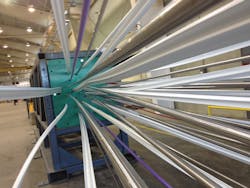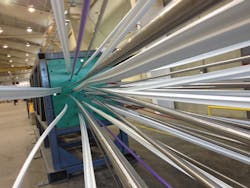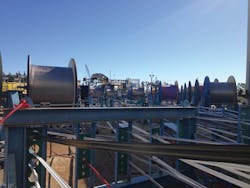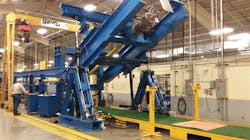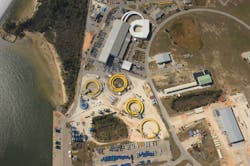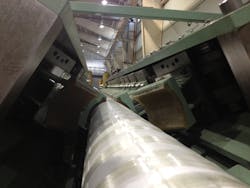Oscilay process speeds production, cuts cost of long-length umbilicals
First deployment offshore China in 2020
Jeremy Beckman, Editor, Europe
CNOOC hassanctioned the first commercial run of a new umbilical manufacturing method for a subsea tieback project in the South China Sea. Aker Solutions’ Oscilay machine will produce the static sections of the Liuhua 16-2 power umbilicals, part of a package of more than 115 km (71.5 mi) of dynamic and static power umbilicals the company is supplying that will connect wells at the deepwater Liuhua 16-2, 20-2 and 21-2 gas-condensate fields to a new FPSO. Aker Solutions is currently constructing a new building to house the Oscilay closing line.
The new process has been designed to address the challenges presented by extreme tension loads on umbilicals during installation, said Greg Ross, the company’s VP Subsea Sales in Asia Pacific at the time of the contract award last summer. Its main benefit is that it eliminates the need for splicing of cables due to manufacturing weight and volume constraints. This is said to enable faster production of large diameter heavy power umbilicals, with positive consequences for offshore project schedules. An Aker Solutions team in Malaysia is leading engineering for the Liuhua project, with the team in Mobile, Alabama, responsible for all production. Final delivery is scheduled for 2020.
Elements coming together in Oscilay static closing point. (All images courtesy Aker Solutions)
Power umbilicals are a critical component of the so-called subsea factory, distributing power from platforms to seabed pumping and production systems in locations often remote from infrastructure. As a paper delivered by Aker Solutions at OTC 2017* pointed out, the design challenges are greater than those of electrohydraulic umbilicals, typically related to heat transfer, corrosion, induced current and splicing. Power umbilicals require much larger-diameter power cables restricting the length and volume that will fit on pay-off reels, which means that each time a reel has to be changed out, splices must be performed. These can often take a week to complete.
Until now, the industry has mainly used vertical or horizontal planetary bundling machines for umbilical manufacture. With the vertical system the elements are placed on a turntable and are twisted together, as they are drawn upwards, to form a cable. For each ‘closing,’ a central element or bundle is pulled through the center of the turntable, allowing new elements to be added. Horizontal cabling machines employ large wheels instead of turntables to carry the machine reels, but otherwise the assembly process is similar to the vertical approach.
SZ stranding
Oscilay is an adaptation of SZ stranding as an alternative closing method. SZ stranding, which has long been applied for bundling smaller cables, involves rotating the tooling that bundles the various elements together. Rotating the tooling back and forth equally for each pattern prevents twist building up between the tooling, element pay-off reels and the take-up reel. The main benefits are that the machine reels are stationary (which is said to make the machinery less costly than planetary systems with a similar capacity), and the fact that the pay-off reels can be sized without volume or weight limitations.
However, power umbilicals are subject to high tensile loads, and applying a high tension to a standard SZ cable would cause it to untwist or straighten out. This action is induced mainly by the torque of the internal SZ stranded elements. Aker Solutions decided to investigate whether it might be possible to modify SZ stranding for long umbilicals. The company’s typical, planetary umbilicals are bundled in one continuous direction with a low lay angle. The elements are bundled into separate holes within the structure, each larger than the element they support in order to facilitate spooling of the umbilical. During bundling, the internal helix elements are given 100% back twist to limit the torque generated by the elements. But the large planetary bundling machines that are needed to rotate the individual element reels also have weight limitations of roughly 25-35 tons for each position in the planetary. The process of closing can therefore be run continuously only for a length corresponding to the same weight or volume range for a single element. Mindful of this limitation and the associated need for more welding and splicing, the team sought to develop and qualify an alternative bundling process that would eliminate the weight and volume constraints. In addition, there are 21 positions in the planetary bundling machine for elements, whereas the Oscilay machine contains theoretically an unlimited number of element positions. That eliminates the need for multiple passes through the closing machine for umbilicals with more than 21 elements.
TOP: Large payoff reels going toward Oscilay closing point.
BELOW: Oscilay prototype umbilical during bend under tension tests.
According to Ruth Pleasant, Senior Engineer and Product Specialist for Oscilay: “The initial ideas for Oscilay started in 2006 when Aker Solutions realized that there was an increasing market for power umbilicals with large power cores. This was due to the growing need for subsea pumping and also the future market for offshore floating wind power. We realized that our bundling machines in Moss, Norway and Mobile, Alabama were not suitable for the high weight and big volumes of the larger power cores being bundled into the umbilicals.
“As shorter-length power cores were needed to suit the weight and volume capacity of a standard planetary machine, our team came up with a new idea which eliminated the weight and volume limitations. This would involve manufacturing a helical bundled umbilical but in an ever-changing direction of the bundling operation, dispensing with the need for planetary action. All elements to be bundled could stay on the ground. The idea was also based on the principle that all axial force should be taken by the internal laid members, even if they were in an alternating helix configuration. We could couple the outer jacket and the internal PVC elements in rotation to balance for the torque generated by the internal elements.
“Aker Solutions holds several patents on this idea, the first being filed in 2007. To prove the concept, the first prototype, which was 70 m [229 ft] long, was assembled by hand in 2007 at the Moss plant. During 2007-2009 several more prototypes were made and compared with analysis to further prove and refine the concept. It became clear that the USAP software, developed by Marintek Norway and applied for the stress analysis, needed further development to properly handle the behavior of the alternating helix configuration. The design and engineering was a team effort between our engineering groups in Fornebu (near Oslo), Moss, and Mobile. They worked together very closely throughout the design, manufacturing and testing of the prototype umbilicals, with the majority of the prototype tests being conducted in Mobile. The Alternating Helix Phase 2 project and the large power umbilical prototype project were executed primarily in Mobile.”
TOP: Large payoff reels going toward Oscilay closing point.
BELOW: Oscilay prototype umbilical during bend under tension tests.
The main driver for the development has been the pressing need to reduce the time taken to make long-length power umbilicals. “Medium-voltage cable splicing takes several days and is quite complex,” Pleasant explained. “This has to be strong, water resistant, electrically sound, and, critically, it needs to have approximately the same diameter as the original cable. Considering that medium-voltage cables usually come in triads, the process could easily last four or five days. If you have to do this every few kilometers, making a 100-km [62-mi] power cable might take most of the year. The opportunity cost of manufacturing something so slowly is prohibitive.
“In order to produce power umbilicals at a pace that would support the market’s needs, Aker Solutions developed what was first known as the Alternating Helix process, later renamed Oscilay. As a nice set of side-effects, the Oscilay process reduces the material handling and requires much lighter machinery.”
Lay pattern
The process follows conventional mono-directional helix stranding principles except for its lay pattern. After a couple of pitch lengths, the direction of closing changes, and the constant switch of lay-direction means there is no need for the individual elements’ pay-off reels to be placed in a planetary or on a turn table. All elements are run into a static closing point and then twisted back and forth. As the umbilical exits the twist head it is taped to maintain the global configuration. The resultant product is then extruded to lock in the umbilical pattern. With this process, there are none of the weight and volume constraints of conventional planetary bundling machines, the company claims.
Among the main beneficiaries are long-length power umbilicals with larger power cores that traditionally reach weight/volume constraints after only 3-4 km (1.8-2.5 mi) of construction. This forces the bundling process to be halted to allow for re-loading and splicing of power cores. With the SZ stranding principle, however, all splicing can be conducted prior to initiating closing, and with more pay-off reels being placed on the ground, the umbilical can always be closed in a single operation.
Aerial view of Aker Solutions’ Mobile, Alabama facility with completed umbilicals on carousels made with traditional horizontal planetary bundling method and payoff reels feeding into the building for the Oscilay closing point.
Aker Solutions decided to evaluate the proposed new process via a series of prototype tests in accordance with recommended DNV practice on qualification of new technology (RP-203, July 2010). The umbilicals used for the qualification would employ the same long lay length and PVC design as the company’s planetary design and would need to withstand the same installation and operation loads. The next steps would be to determine what was new about the technology and what was field proven, and to assess the key areas of focus during the qualification program using failure modes effects analysis (FMEA). To support the development, the company invited offshore operators, installation contractors, and engineering groups to suggest potential failure modes for the umbilical manufacturing, installation and operational phases, many of which would be addressed during the testing phase.
In addition, it resolved to conduct standard tests in accordance with API 17E:2010 in order to compare the SZ stranded umbilical with a standard planetary umbilical. The aim was to draw up an envelope for making steel tube and power umbilicals without the need for extensive, project-specific tests. For the critical tensile testing the company opted for a steel tube umbilical cross-section that would have required two passes through the cabling machine, thereby ensuring smaller umbilicals would easily comply with the highest-risk failure modes identified by the FMEA.
Three different prototypes were manufactured with much of the testing completed prior to spring 2017. The main considerations that influenced the testing program included unpredictable behavior during spooling and reeling due to the new lay pattern; load sharing among elements toward the center of the cross-sections vs those elements toward the outer periphery; filling of the grooves in the PVC profiles and the subsequent effect on the umbilical when subjected to high tensile loads; whether the machine would have the capacity to twist an umbilical incorporating 15-ksi steel tubes; and whether the process would suit umbilical-grade flying leads. The trials conducted included handling, spooling, reeling, tensile testing, bending stiffness testing, bend under tension testing, crush testing, and flex fatigue testing.
Oscilay prototype umbilical taped and entering tensioner.
According to David Hickman, Product Manager, Umbilicals at Aker Solutions, “one of the prototypes was a 171-mm OD steel tube umbilical (STU) sample containing twelve ¾-in. 15-ksi lines, four ½-in. 15-ksi lines, three 10-sq mm [0.01-sq in.] quads and three 16 SMF fiber optic cables. A total of 600 m [1,968 ft] was produced. Another was an umbilical-grade flying lead (UFL) sample containing ten ½-in. 10-ksi lines. In total 250 m [820 ft] was produced. Both the STU sample and the UFL were tested according to ISO-standard requirements. These two projects were designed to be very close to previously executed planetary umbilical projects so that the results of testing and analysis could be compared.”
The third prototype was a complex power umbilical manufactured and tested to suit the requirements of a major oil company. It included three 630-sq mm (0.97-sq in.) 36kV cables, 16 SMF fiber optic cables, fiber optic sensors, steel rods, and carbon fiber rods. A total of 1,000 m (3,281 ft) was manufactured. “In order to better understand the technology’s capabilities, many hand samples were also made prior to producing these umbilicals with the Oscilay machine,” Hickman added.
Results from the qualification program suggested that Oscilay stranding would perform well, even in deepwater, and that the technique could withstand the same tensile, compression and internal pressure loads as a planetary umbilical. “The samples tested exhibited improved fatigue capacity and high torsional stability,” Hickman said, “but the same applies to all Aker Solutions umbilicals. Since each element is placed in its own conduit, element friction forces are lower than with our competitors’ products, and the reduced friction stress lowers the fatigue damage on large power cores.
“The overall mechanical properties for an Oscilay umbilical, such as tensile capacities and minimum bending radii, are the same as for planetary umbilicals that the company has delivered since 1994. The main benefit to our clients is that this technology requires fewer splices, which means reduced risk. Also, we can deliver faster since splicing is very time and labor-intensive.
“We are now purchasing larger reels for projects to make full use of the Oscilay technology. This will allow us to make the full lengths with no splices. Case studies, tenders, and active projects show a reduction in cost of over 5% while also eliminating the cable splices.”
First Oscilay production is due to start in 3Q 2019, although the new building and equipment will be ready by mid-year. “This manufacturing line will greatly increase the capacity of the Mobile facility,” Hickman said. “Since the Oscilay machine is small, easily moved and very simple, a basic building design is required. The first umbilical to be produced using the new process will contain medium-voltage cables and will be an Aker Solutions standard PVC design. There are no planned splices during closing since the project is taking full advantage of Oscilay’s benefits.” •
Reference
*Arild Figenschou, David Hickman, and Leif Høie, Aker Solutions, ‘New Umbilical Manufacturing Method Eliminates Weight Limitation,’ Offshore Technology Conference 2017, Houston.
